Max Bain
Shot-by-Shot: Film-Grammar-Aware Training-Free Audio Description Generation
Apr 01, 2025Abstract:Our objective is the automatic generation of Audio Descriptions (ADs) for edited video material, such as movies and TV series. To achieve this, we propose a two-stage framework that leverages "shots" as the fundamental units of video understanding. This includes extending temporal context to neighbouring shots and incorporating film grammar devices, such as shot scales and thread structures, to guide AD generation. Our method is compatible with both open-source and proprietary Visual-Language Models (VLMs), integrating expert knowledge from add-on modules without requiring additional training of the VLMs. We achieve state-of-the-art performance among all prior training-free approaches and even surpass fine-tuned methods on several benchmarks. To evaluate the quality of predicted ADs, we introduce a new evaluation measure -- an action score -- specifically targeted to assessing this important aspect of AD. Additionally, we propose a novel evaluation protocol that treats automatic frameworks as AD generation assistants and asks them to generate multiple candidate ADs for selection.
AutoAD-Zero: A Training-Free Framework for Zero-Shot Audio Description
Jul 22, 2024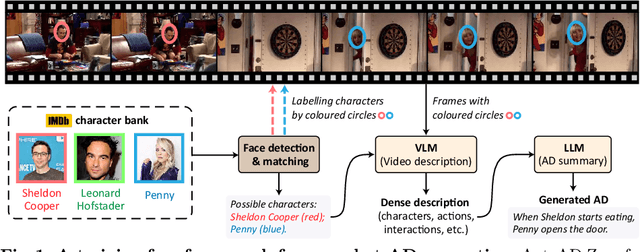

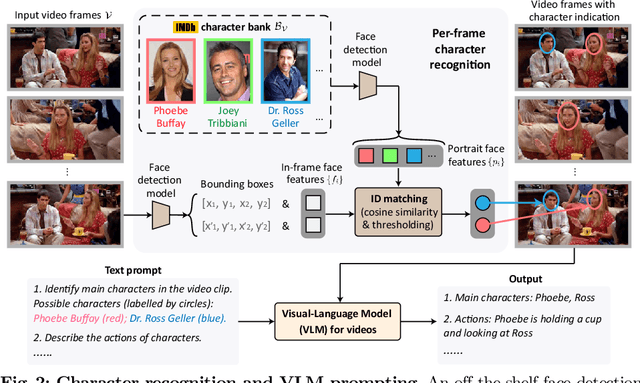

Abstract:Our objective is to generate Audio Descriptions (ADs) for both movies and TV series in a training-free manner. We use the power of off-the-shelf Visual-Language Models (VLMs) and Large Language Models (LLMs), and develop visual and text prompting strategies for this task. Our contributions are three-fold: (i) We demonstrate that a VLM can successfully name and refer to characters if directly prompted with character information through visual indications without requiring any fine-tuning; (ii) A two-stage process is developed to generate ADs, with the first stage asking the VLM to comprehensively describe the video, followed by a second stage utilising a LLM to summarise dense textual information into one succinct AD sentence; (iii) A new dataset for TV audio description is formulated. Our approach, named AutoAD-Zero, demonstrates outstanding performance (even competitive with some models fine-tuned on ground truth ADs) in AD generation for both movies and TV series, achieving state-of-the-art CRITIC scores.
Vibe-Eval: A hard evaluation suite for measuring progress of multimodal language models
May 03, 2024
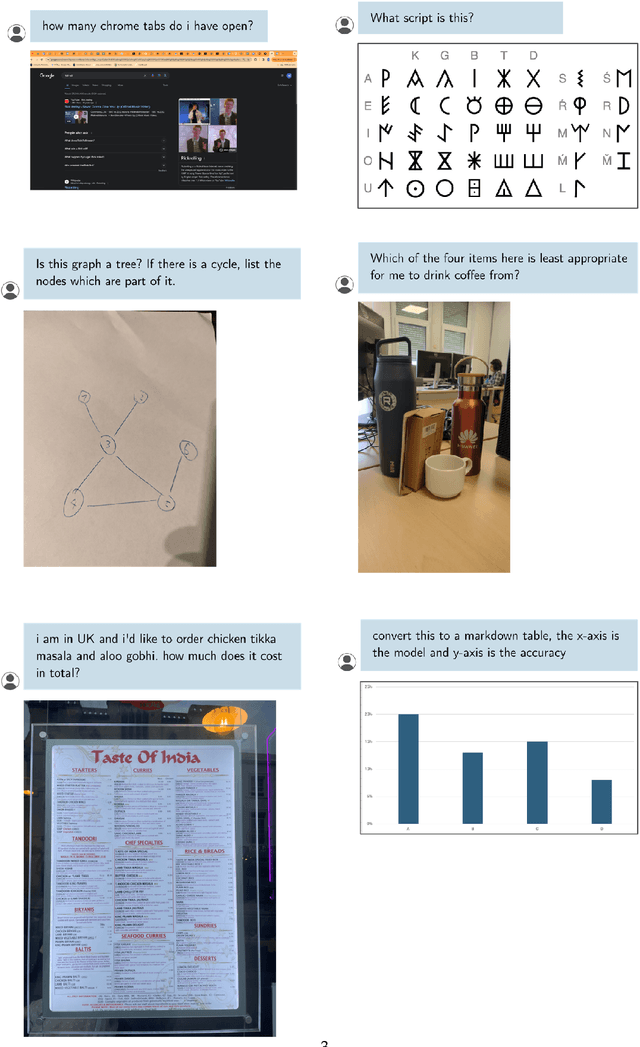
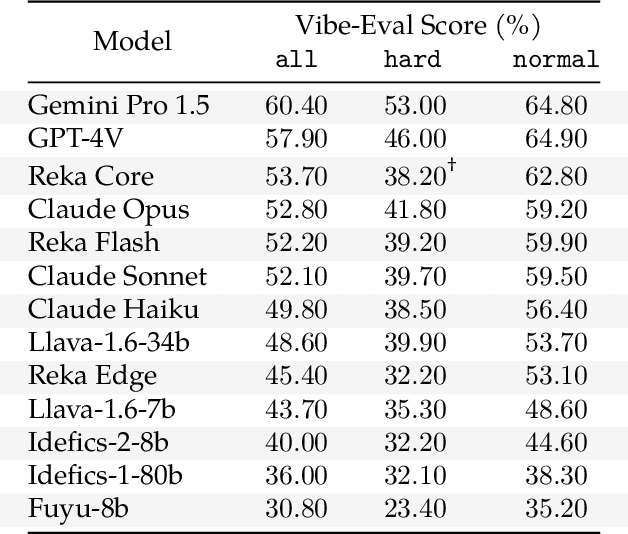
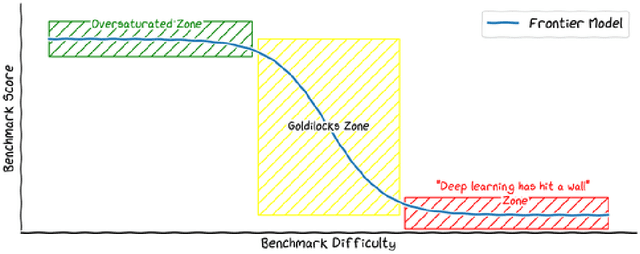
Abstract:We introduce Vibe-Eval: a new open benchmark and framework for evaluating multimodal chat models. Vibe-Eval consists of 269 visual understanding prompts, including 100 of hard difficulty, complete with gold-standard responses authored by experts. Vibe-Eval is open-ended and challenging with dual objectives: (i) vibe checking multimodal chat models for day-to-day tasks and (ii) rigorously testing and probing the capabilities of present frontier models. Notably, our hard set contains >50% questions that all frontier models answer incorrectly. We explore the nuances of designing, evaluating, and ranking models on ultra challenging prompts. We also discuss trade-offs between human and automatic evaluation, and show that automatic model evaluation using Reka Core roughly correlates to human judgment. We offer free API access for the purpose of lightweight evaluation and plan to conduct formal human evaluations for public models that perform well on the Vibe-Eval's automatic scores. We release the evaluation code and data, see https://github.com/reka-ai/reka-vibe-eval
AutoAD III: The Prequel -- Back to the Pixels
Apr 22, 2024Abstract:Generating Audio Description (AD) for movies is a challenging task that requires fine-grained visual understanding and an awareness of the characters and their names. Currently, visual language models for AD generation are limited by a lack of suitable training data, and also their evaluation is hampered by using performance measures not specialized to the AD domain. In this paper, we make three contributions: (i) We propose two approaches for constructing AD datasets with aligned video data, and build training and evaluation datasets using these. These datasets will be publicly released; (ii) We develop a Q-former-based architecture which ingests raw video and generates AD, using frozen pre-trained visual encoders and large language models; and (iii) We provide new evaluation metrics to benchmark AD quality that are well-matched to human performance. Taken together, we improve the state of the art on AD generation.
Reka Core, Flash, and Edge: A Series of Powerful Multimodal Language Models
Apr 18, 2024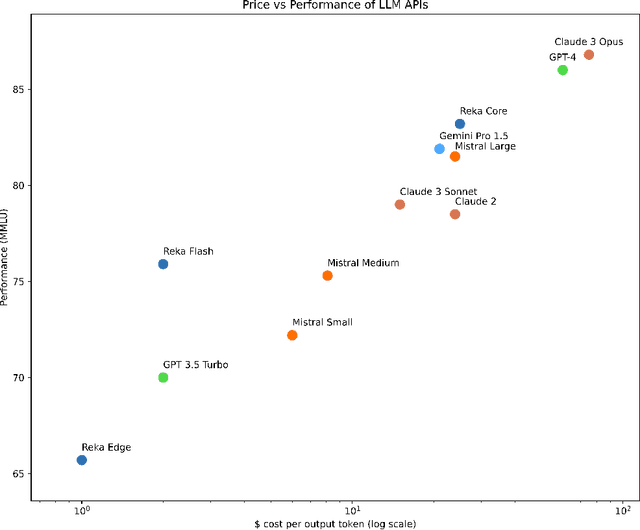


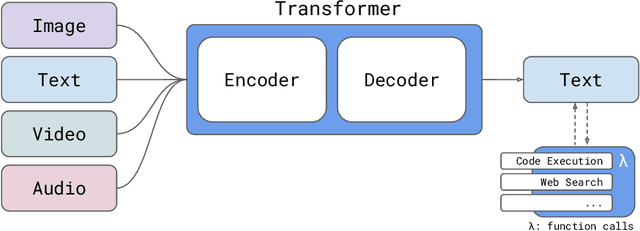
Abstract:We introduce Reka Core, Flash, and Edge, a series of powerful multimodal language models trained from scratch by Reka. Reka models are able to process and reason with text, images, video, and audio inputs. This technical report discusses details of training some of these models and provides comprehensive evaluation results. We show that Reka Edge and Reka Flash are not only state-of-the-art but also outperform many much larger models, delivering outsized values for their respective compute class. Meanwhile, our most capable and largest model, Reka Core, approaches the best frontier models on both automatic evaluations and blind human evaluations. On image question answering benchmarks (e.g. MMMU, VQAv2), Core performs competitively to GPT4-V. Meanwhile, on multimodal chat, Core ranks as the second most preferred model under a blind third-party human evaluation setup, outperforming other models such as Claude 3 Opus. On text benchmarks, Core not only performs competitively to other frontier models on a set of well-established benchmarks (e.g. MMLU, GSM8K) but also outperforms GPT4-0613 on human evaluation. On video question answering (Perception-Test), Core outperforms Gemini Ultra. Models are shipped in production at http://chat.reka.ai . A showcase of non cherry picked qualitative examples can also be found at http://showcase.reka.ai .
AutoAD II: The Sequel -- Who, When, and What in Movie Audio Description
Oct 10, 2023



Abstract:Audio Description (AD) is the task of generating descriptions of visual content, at suitable time intervals, for the benefit of visually impaired audiences. For movies, this presents notable challenges -- AD must occur only during existing pauses in dialogue, should refer to characters by name, and ought to aid understanding of the storyline as a whole. To this end, we develop a new model for automatically generating movie AD, given CLIP visual features of the frames, the cast list, and the temporal locations of the speech; addressing all three of the 'who', 'when', and 'what' questions: (i) who -- we introduce a character bank consisting of the character's name, the actor that played the part, and a CLIP feature of their face, for the principal cast of each movie, and demonstrate how this can be used to improve naming in the generated AD; (ii) when -- we investigate several models for determining whether an AD should be generated for a time interval or not, based on the visual content of the interval and its neighbours; and (iii) what -- we implement a new vision-language model for this task, that can ingest the proposals from the character bank, whilst conditioning on the visual features using cross-attention, and demonstrate how this improves over previous architectures for AD text generation in an apples-to-apples comparison.
OxfordVGG Submission to the EGO4D AV Transcription Challenge
Jul 18, 2023Abstract:This report presents the technical details of our submission on the EGO4D Audio-Visual (AV) Automatic Speech Recognition Challenge 2023 from the OxfordVGG team. We present WhisperX, a system for efficient speech transcription of long-form audio with word-level time alignment, along with two text normalisers which are publicly available. Our final submission obtained 56.0% of the Word Error Rate (WER) on the challenge test set, ranked 1st on the leaderboard. All baseline codes and models are available on https://github.com/m-bain/whisperX.
Balancing the Picture: Debiasing Vision-Language Datasets with Synthetic Contrast Sets
May 24, 2023Abstract:Vision-language models are growing in popularity and public visibility to generate, edit, and caption images at scale; but their outputs can perpetuate and amplify societal biases learned during pre-training on uncurated image-text pairs from the internet. Although debiasing methods have been proposed, we argue that these measurements of model bias lack validity due to dataset bias. We demonstrate there are spurious correlations in COCO Captions, the most commonly used dataset for evaluating bias, between background context and the gender of people in-situ. This is problematic because commonly-used bias metrics (such as Bias@K) rely on per-gender base rates. To address this issue, we propose a novel dataset debiasing pipeline to augment the COCO dataset with synthetic, gender-balanced contrast sets, where only the gender of the subject is edited and the background is fixed. However, existing image editing methods have limitations and sometimes produce low-quality images; so, we introduce a method to automatically filter the generated images based on their similarity to real images. Using our balanced synthetic contrast sets, we benchmark bias in multiple CLIP-based models, demonstrating how metrics are skewed by imbalance in the original COCO images. Our results indicate that the proposed approach improves the validity of the evaluation, ultimately contributing to more realistic understanding of bias in vision-language models.
AutoAD: Movie Description in Context
Mar 29, 2023Abstract:The objective of this paper is an automatic Audio Description (AD) model that ingests movies and outputs AD in text form. Generating high-quality movie AD is challenging due to the dependency of the descriptions on context, and the limited amount of training data available. In this work, we leverage the power of pretrained foundation models, such as GPT and CLIP, and only train a mapping network that bridges the two models for visually-conditioned text generation. In order to obtain high-quality AD, we make the following four contributions: (i) we incorporate context from the movie clip, AD from previous clips, as well as the subtitles; (ii) we address the lack of training data by pretraining on large-scale datasets, where visual or contextual information is unavailable, e.g. text-only AD without movies or visual captioning datasets without context; (iii) we improve on the currently available AD datasets, by removing label noise in the MAD dataset, and adding character naming information; and (iv) we obtain strong results on the movie AD task compared with previous methods.
WhisperX: Time-Accurate Speech Transcription of Long-Form Audio
Mar 01, 2023Abstract:Large-scale, weakly-supervised speech recognition models, such as Whisper, have demonstrated impressive results on speech recognition across domains and languages. However, their application to long audio transcription via buffered or sliding window approaches is prone to drifting, hallucination & repetition; and prohibits batched transcription due to their sequential nature. Further, timestamps corresponding each utterance are prone to inaccuracies and word-level timestamps are not available out-of-the-box. To overcome these challenges, we present WhisperX, a time-accurate speech recognition system with word-level timestamps utilising voice activity detection and forced phoneme alignment. In doing so, we demonstrate state-of-the-art performance on long-form transcription and word segmentation benchmarks. Additionally, we show that pre-segmenting audio with our proposed VAD Cut & Merge strategy improves transcription quality and enables a twelve-fold transcription speedup via batched inference.
 Add to Chrome
Add to Chrome Add to Firefox
Add to Firefox Add to Edge
Add to Edge